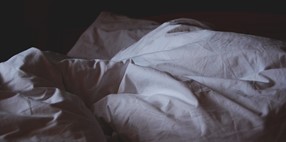Spain’s first multi-sensory room for the treatment of addictions and mental disorders
The Mental Healthcare and Addictions Day Hospital of the Centre for Mental Health and Addictions (CSMIA) began operating in April 2021. It has created Spain’s first multi-sensory room (Snoezelen) for dual disorder patients (a mental disorder and an addiction). Snoezelen rooms are normally used for patients with dementia or a disability, but this is the first time they have been used in mental health and drug addiction. Use of this multi-sensory room is intended to promote states of relaxation, to reduce anxiety, to boost self-control and to encourage a sense of well-being in patients with these disorders.
Description
The Mental Health and Addictions Day Hospital of the Centre for Mental Health and Addictions (CSMIA) began operating in April 2021 in Barcelona’s Gràcia district. This facility is designed to accommodate people diagnosed with dual disorders who are actively consuming or in remission for the different substances they use. Although the centre is administered by the Hospital Mare de Déu de la Mercé, it is located at the Hospital de l'Esperança.
The Hospital Mare de Déu de la Mercé is a Congregation of the Sisters Hospitallers of the Sacred Heart of Jesus healthcare complex that comprises several facilities at different sites in Barcelona. Since it began operating, the organization has worked intensely in social and health care and mental health.
The Congregation of the Sisters Hospitallers of the Sacred Heart of Jesus is a Catholic church non-profit institution, which has been working for over 135 years in admissions, personalized treatment, comprehensive care and social reintegration of people with mental illness, intellectual disabilities and other illnesses, while prioritizing the most vulnerable groups, in line with the needs at any given time and place.
The Sisters Hospitallers have always encouraged new treatments in dual disorders, which is why the first multi-sensory (Snoezelen) room in Spain for patients with mental disorders was created at the CSMIA.
The Snoezelen room operates from 9 am to 5 pm from Monday to Friday and offers a programme of group and psycho-educational workshops (50 minutes with 10-minute break) that cover: daily and weekly goals, impulse control, financial education and economic and family management, self-awareness and sexuality, leisure and free time, assembly, social and labour reintegration, healthy habits, self-awareness and personal growth, mindfulness, harm reduction, sport, yoga, daily emotional management, intensive addiction therapy, social skills, conscious medication and illness awareness, creative writing and keeping a personal diary, relaxation, therapeutic outings and English and Catalan classes.
The professionals from the service (psychologist, social integrator, social worker, nurse and psychiatrist) provide group, individual and family care.
The supervised participation of volunteer staff or patient experts is also encouraged, as are colloquiums and debates with invited experts on topics of current interest. Use of the multi-sensory room is mainly intended to promote states of relaxation, to reduce anxiety, to enhance self-control and to encourage a sense of wellbeing.
To use the new room, the Hospital Mare de Déu de la Mercé has trained around twenty employees from different disciplines (psychology, psychiatry, physiotherapy, nursing, social work, occupational therapy, social integration and social education) to provide multi-sensory therapy applied to mental illness. Their work includes individualized analysis of stimuli that bring patients wellbeing or those that are unpleasant. This provides the basis to offer 40-minute sessions with stimuli favourable to the patient, so that he/she can feel safe and secure.
Training of the employees is acknowledged and endorsed as part of International multi-sensory stimulation and Snoezelen training, ISNA (International Snoezelen Association, www.isna-mse.org). Upon completion of the 3 training modules, an international qualification with ISNA recognition is offered. Training consists of 3 modules (20 hours onsite + 5 hours of work in each module). Total: 75 hours of training. Overall, training consists of 50% theoretical content and 50% practical content. It is recommended that a period of time should be left between each of the 3 modules for the implementation of the knowledge and intervention practices learned in each module prior to continuing with the next module.
Work in this room is given on an individual basis to suit each patient’s sensory profile. The stimuli that bring them wellbeing and those that are unpleasant are therefore analysed. The aim is to offer the patient, in a 20- to 40-minute period, sensations that are pleasant so that he/she can feel safe and secure during the session. The experience is also intended to provide learning that patients can take home, in order to help them to remember the sensations experienced in the room.
Procedure:
Each patient is allocated 1 hour a week. This includes 30 minutes of data collection outside the room and 30 minutes of therapy in the room. The 8 sessions are divided into two groups: structured (sessions 1 to 4) and flexible (sessions 5 to 8).
• Session 1: First passive session. This session is intended for the patient to get used to the Snoezelen room. The patient lies on the waterbed with relaxing music in the background and single-coloured background lighting. Halfway through the session the lights are switched to passive mode.
• Session 2: focused on the bubble tube and the die. Oil projection is also used. This session is accompanied by lights in passive mode, should the patient show no interest in using the die to change the colour of the lighting and prefers it to change automatically.
• Session 3: projection of an image or video, with background music and lights in passive mode. the patient sits on a pouffe on the floor.
• Session 4: this session is based mainly on tactile stimulation. the patient stays wherever he/she wants in the room. Work involves manual massage tools, as well as the activation of lights in passive mode and accompanying relaxing music.
• Session 5-8: Sessions five to eight are adapted much more to the patient’s tastes and preferences. In these, the professional accommodates the type of stimulation the patient wishes to receive, which could be a repetition of a previous session or a combination of several stimuli from different sessions. For example, a patient might choose to watch a projection while receiving tactile stimulation (devices used in sessions 3 and 4 respectively).
Unlike other existing Snoezelen rooms in Spain used for patients with dementia or disability with a view to improving the user’s wellbeing through sensory stimulation, in the case of mental illness, the aim is to foster the individual’s psychological/emotional stability. In people with dual disorders, who have full cognitive capacities and can therefore take active part in the treatment, these spaces become an environment conducive to their psychological and emotional stability. This improves and speeds up their recovery and the effects of treatments.
Needs
The Sisters Hospitallers have always encouraged new treatments in dual disorders, which is why the first multi-sensory room (Snoezelen) in Spain for patients with dual disorders (mental disorder and an addiction) was created at the CSMIA.
The multi-sensory room was created in order to:
• Encourage states of relaxation in patients
• Reduce patients’ anxiety
• Enhance patients’ self-control
• Encourage a sense of wellbeing
Results
Customer satisfaction. 100% of patients state that they feel more present with the multi-sensory room.
Year
2021
Price
Unspecified
Team
Comments
After each session, a series of tests was run on each patient, the results of which are detailed below:
• Blood pressure. According to Ruiz (2012) optimal blood pressure when active is 120/80, at rest is 100/65 and over 24 hrs. is 115/75. Measurements for patients in the study stabilized considerably after sessions, as beforehand blood pressure was either very high or very low yet afterwards lay within the optimal parameters. Similarly, the mean obtained with other constants taken such as pulse rate, also changed and calmed down in all cases.
• State-Trait Anxiety Inventory (STAI, Fonseca-Pedrero, et al, 2012): most people in the study answered “not at all” in a pre-questionnaire and “moderately so” in the post-test of the same questionnaire with regard to the items of feeling calm (item 1), secure (item 2), at ease (item 5), comfortable (item 10) or relaxed (item 15). Answers, however, ranged from “very much so” in the pre-questionnaire before entering the room, to “not at all” in a post-questionnaire after the exposure to the room, with regard to the items of being tense (item 3), strained (item 4), and upset (item 6), among others.
• Body Shape Questionnaire, BSQ, (Cooper et al, 1987): the mean scores are lower after intervention in the room. All the results confirm that the stay in the room makes patients more aware of their mental illness and gives them a sense of being able to take control of their life as they engage with a part of themselves that in their daily life remains unchecked, either because of fear of not controlling the alterations inherent in their condition, or because of the consumption pattern established over several years. The experience in the room reduces their desire to consume and, in some cases, leads to a decrease in their medication regimen for stress and anxiety.
They all confirm that the stay in the room makes them feel more present, more aware of their mental illness and gives them a feeling of being able to take control of their own life through engagement with a part of themselves that in their daily life remains unchecked (either because of fear of not controlling the alterations inherent in their condition, or because of the consumption pattern established over several years.). The experience in the room reduces their desire to consume and, in some cases, leads to a decrease in their medication regimen for stress and anxiety.
After use of the multi-sensory room, we can therefore conclude that:
• Vital signs such as blood pressure and pulse stabilize.
• Patients treated in the room significantly reduce their anxiety and stress levels.
• Drug consumption decreases in patients with drug dependence.
Published on*** 13 Jun 2022




















